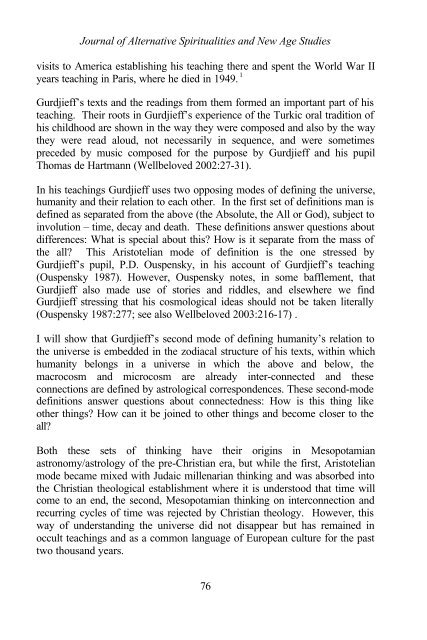Gurdjieff, 'Old' or 'New Age': Aristotle or Astrology? Sophia ...
Gurdjieff, 'Old' or 'New Age': Aristotle or Astrology? Sophia ...
Gurdjieff, 'Old' or 'New Age': Aristotle or Astrology? Sophia ...
You also want an ePaper? Increase the reach of your titles
YUMPU automatically turns print PDFs into web optimized ePapers that Google loves.
Journal of Alternative Spiritualities and New Age Studies<br />
visits to America establishing his teaching there and spent the W<strong>or</strong>ld War II<br />
years teaching in Paris, where he died in 1949. 1<br />
<strong>Gurdjieff</strong>’s texts and the readings from them f<strong>or</strong>med an imp<strong>or</strong>tant part of his<br />
teaching. Their roots in <strong>Gurdjieff</strong>’s experience of the Turkic <strong>or</strong>al tradition of<br />
his childhood are shown in the way they were composed and also by the way<br />
they were read aloud, not necessarily in sequence, and were sometimes<br />
preceded by music composed f<strong>or</strong> the purpose by <strong>Gurdjieff</strong> and his pupil<br />
Thomas de Hartmann (Wellbeloved 2002:27-31).<br />
In his teachings <strong>Gurdjieff</strong> uses two opposing modes of defining the universe,<br />
humanity and their relation to each other. In the first set of definitions man is<br />
defined as separated from the above (the Absolute, the All <strong>or</strong> God), subject to<br />
involution – time, decay and death. These definitions answer questions about<br />
differences: What is special about this? How is it separate from the mass of<br />
the all? This Aristotelian mode of definition is the one stressed by<br />
<strong>Gurdjieff</strong>’s pupil, P.D. Ouspensky, in his account of <strong>Gurdjieff</strong>’s teaching<br />
(Ouspensky 1987). However, Ouspensky notes, in some bafflement, that<br />
<strong>Gurdjieff</strong> also made use of st<strong>or</strong>ies and riddles, and elsewhere we find<br />
<strong>Gurdjieff</strong> stressing that his cosmological ideas should not be taken literally<br />
(Ouspensky 1987:277; see also Wellbeloved 2003:216-17) .<br />
I will show that <strong>Gurdjieff</strong>’s second mode of defining humanity’s relation to<br />
the universe is embedded in the zodiacal structure of his texts, within which<br />
humanity belongs in a universe in which the above and below, the<br />
macrocosm and microcosm are already inter-connected and these<br />
connections are defined by astrological c<strong>or</strong>respondences. These second-mode<br />
definitions answer questions about connectedness: How is this thing like<br />
other things? How can it be joined to other things and become closer to the<br />
all?<br />
Both these sets of thinking have their <strong>or</strong>igins in Mesopotamian<br />
astronomy/astrology of the pre-Christian era, but while the first, Aristotelian<br />
mode became mixed with Judaic millenarian thinking and was abs<strong>or</strong>bed into<br />
the Christian theological establishment where it is understood that time will<br />
come to an end, the second, Mesopotamian thinking on interconnection and<br />
recurring cycles of time was rejected by Christian theology. However, this<br />
way of understanding the universe did not disappear but has remained in<br />
occult teachings and as a common language of European culture f<strong>or</strong> the past<br />
two thousand years.<br />
76










